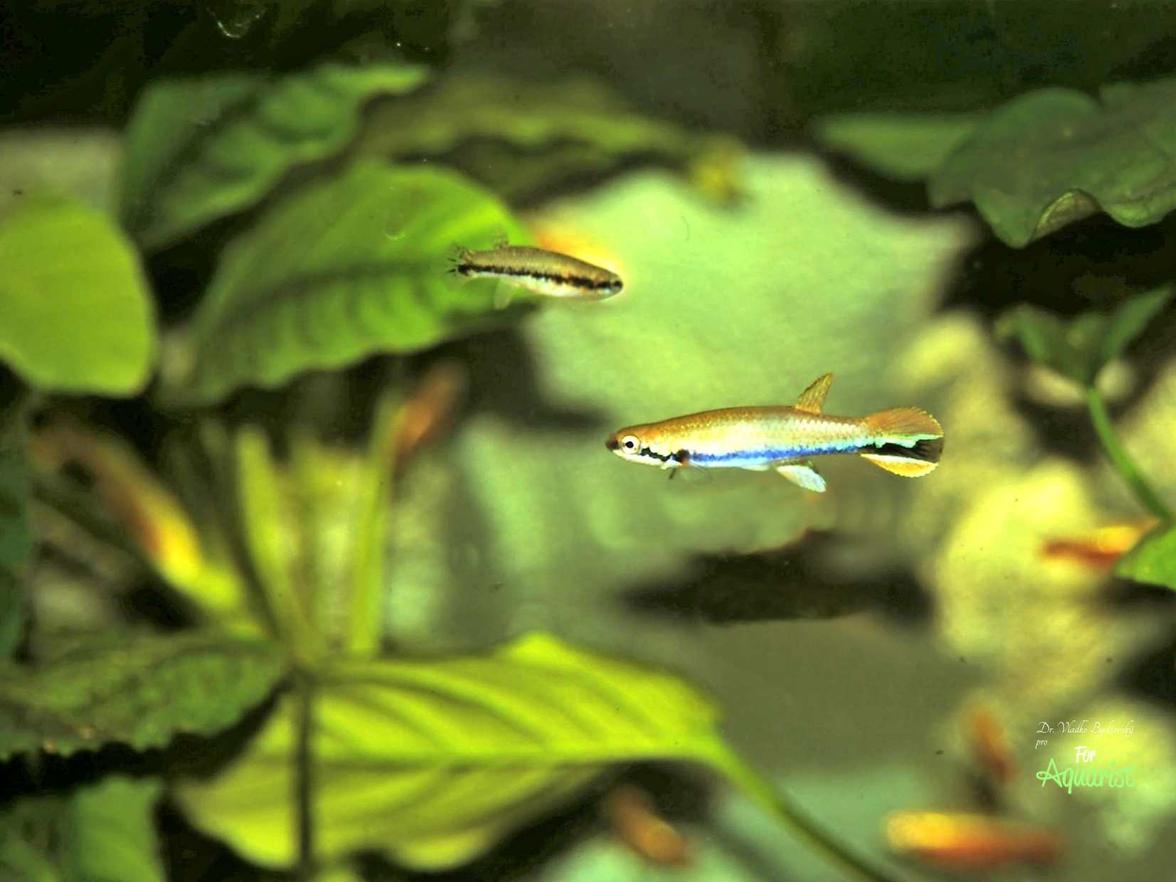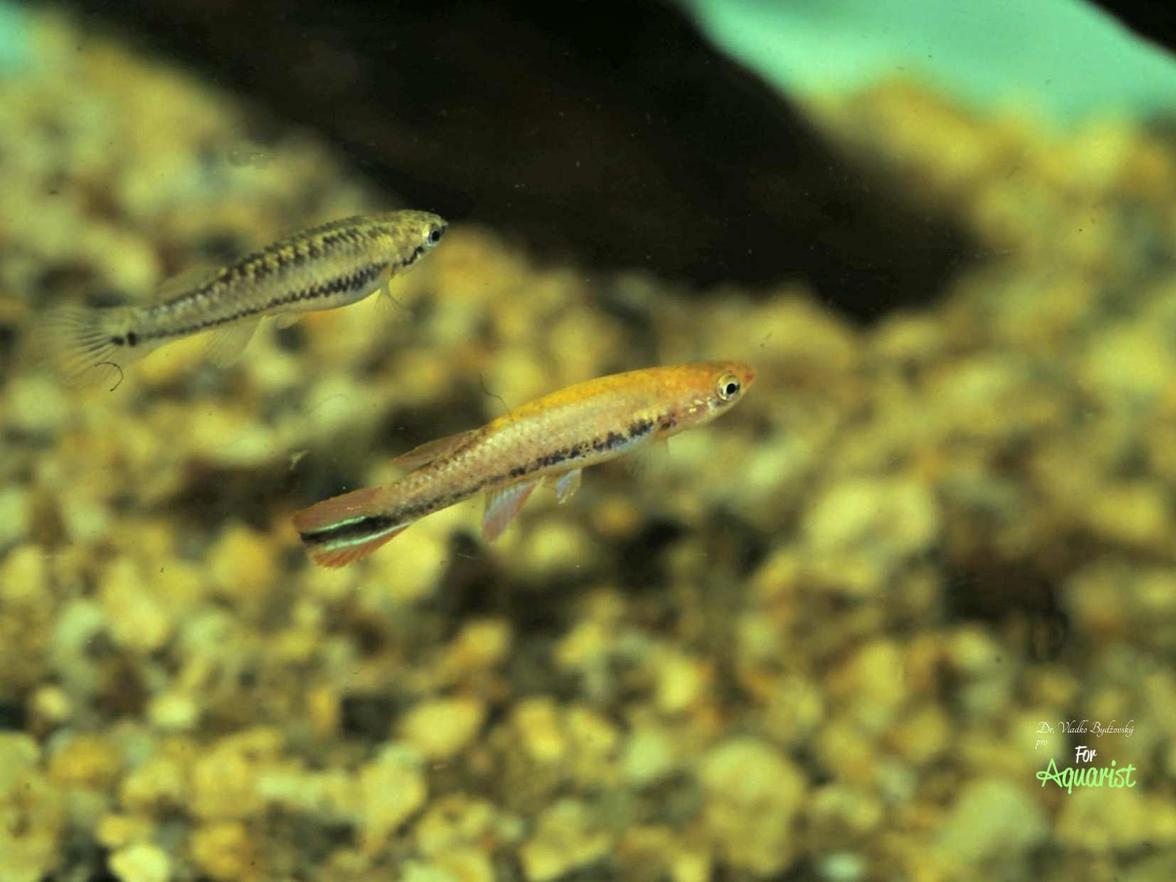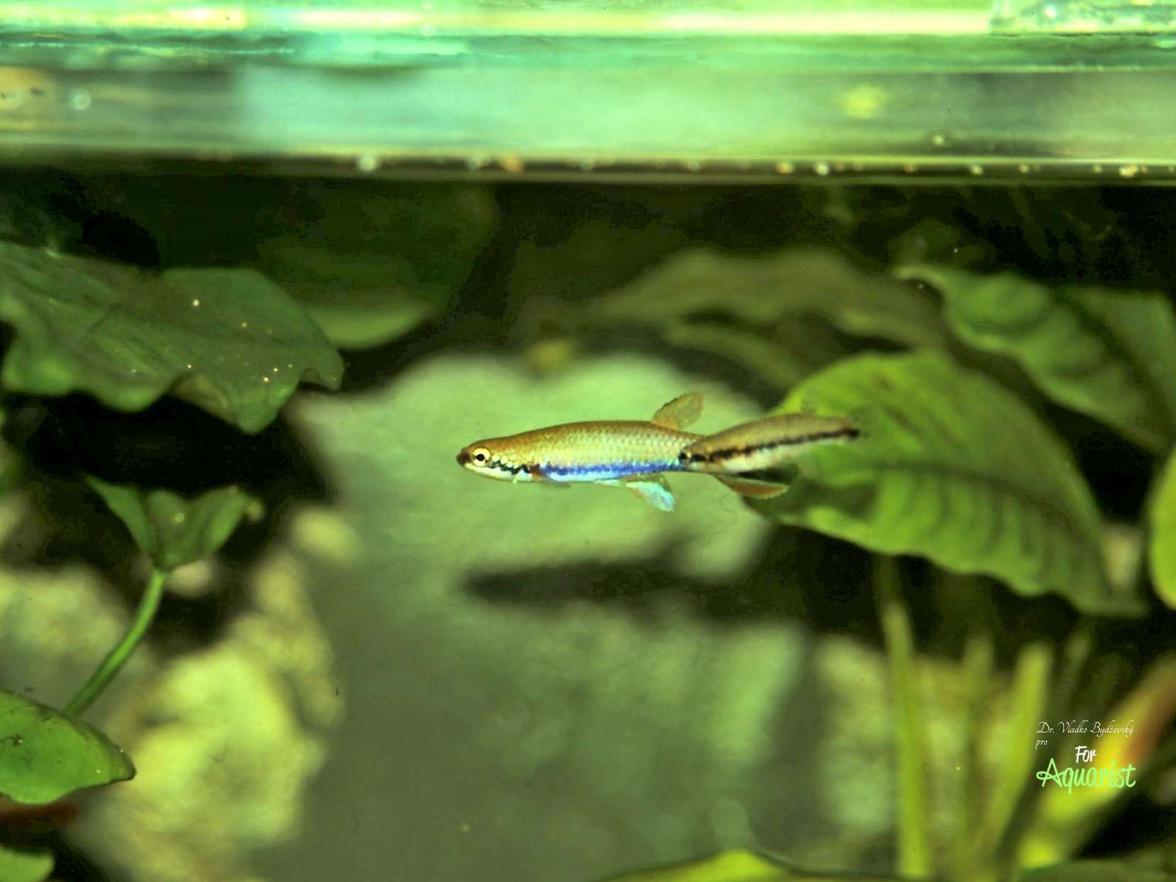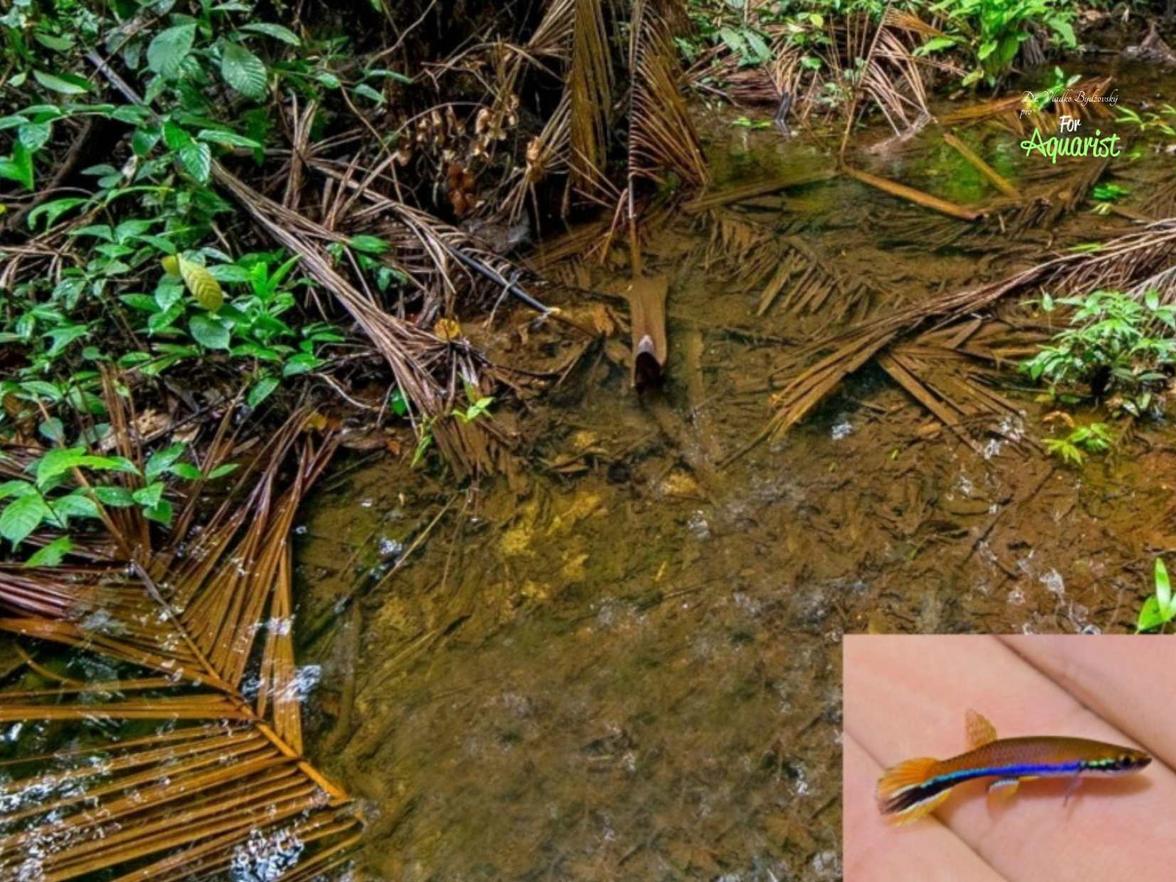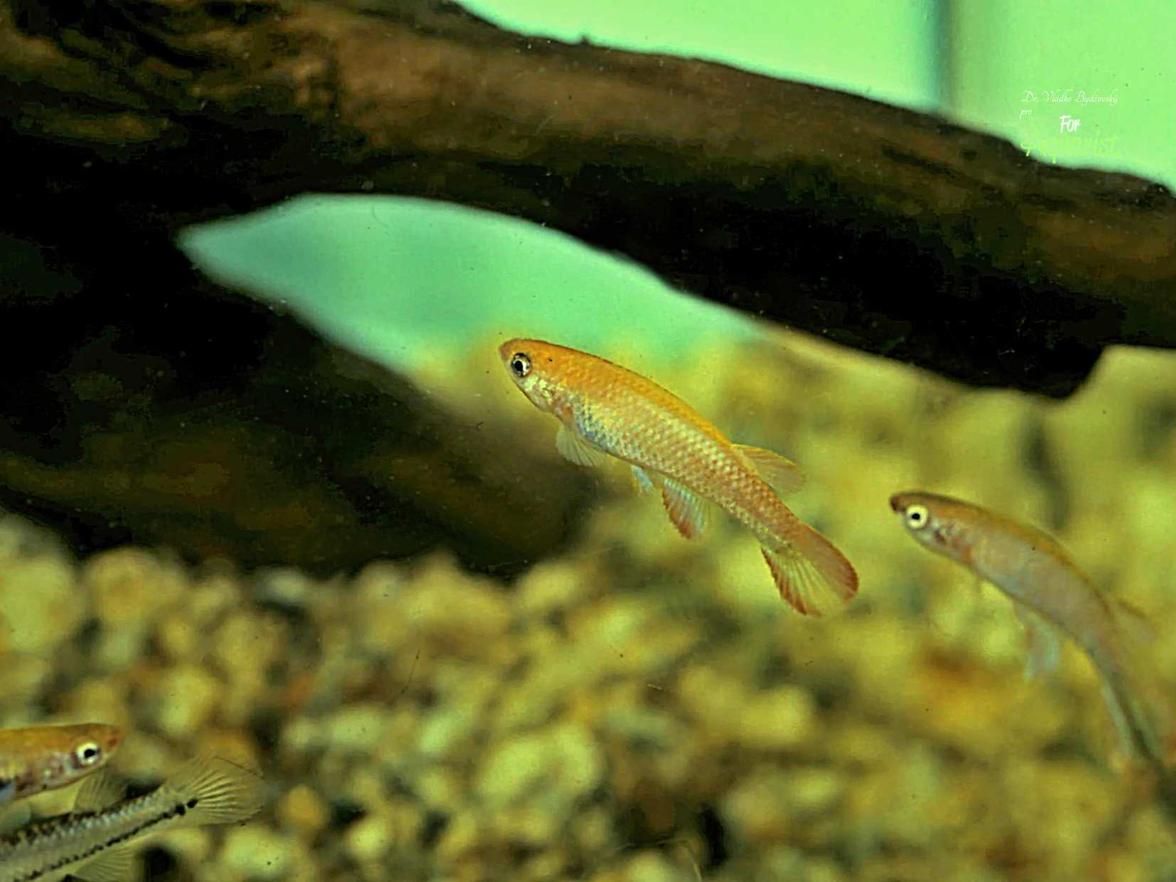Laimosemion xiphidius: My king among the killifish and the story of his breeding
This article will take you into the fascinating world of Laimosemion xiphidius, a fish that the author affectionately calls "the king among killifish." Dive into personal experiences with breeding and raising this South American gem, discover its history, natural occurrence, and the specifics that make the swordtail killifish an exceptional challenge and joy for every aquarist.
In my life, I have kept a number of African and South American killifish, but I have the warmest relationship with three species. I have devoted the most attention to breeding the African species Pseudoepiplatys annulatus, of which I have bred thousands in the past.
A bigger problem was the breeding and rearing of the species Diapteron cyanostictus. However, my most significant relationship is with the South American species Laimosemion (Rivulus) xiphidius, which is my king among killifish. The name of the fish is derived from the Greek xiphos – sword, or xiphidium – small sword. Keeping the fish at home in good condition for several years in an aquarium and even breeding it is among the peaks of the art of killifish keeping. Most older killifish keepers, however, know the fish rather under the genus designation Rivulus.
Discovery of the fish
The first reports of this gem appeared in 1925 (PLANQUETTE et al., 1996), when Dr. Carl TERNETZ caught the fish during his Brazilian journey in a stream that flows into the upper reaches of the Approuague. Officially, however, the fish was discovered by botanist Patrick BLANCK in 1978, and a year later, the fish he caught was scientifically described by French ichthyologist Jean HUBER. He is known in our literature for his revisions of the systematics of killifish and was among the world's greatest experts on killifish, having written extensively about the killifish species. The type specimen can be found at the border with Brazil, south of the town of St. Georges in the Oyapock River. However, the fish is quite widespread in lowland areas near the coast and is one of the smaller representatives of its genus.
Natural occurrence
Scientific works so far mainly mention localities in French Guiana, while other literary data also indicate Suriname and the border area of Brazil.
They mostly live in the side channels of streams in places where the water is mostly stagnant. On the sandy bottom, numerous leaves from surrounding trees are deposited. The water is soft, slightly acidic, with very low total hardness, around 0-1°dGH. It is usually referred to as so-called clear water. Together with Laimosemion xiphidius, Rivulus geayi also live there, and some shrimp and crabs have also been found. In other places, there are also Copella arnoldi, some species of the genus Pyrrhulina, Rivulus agilae, Rivulus cf. urophthalmus, Rivulus urophthalmus, Rivulus aff. holmiae, some small cichlids - Nannacara anomala, Nannacara aureocephalus, but also representatives of the genera Aequidens, Crenicara.
STAECK (2004) visited two localities – a place at Chutes de Fourgassié, where very clear water had a pH of 6.7, dGH and dKH below 1°, electrical conductivity 20µS/cm, temperature 24°C. The other locality was a relatively large stream Crique Soumourou near the town of Sinnamary with typically strongly brown-colored water.
Total and carbonate hardness was below 1°dH, electrical conductivity 10 µS/cm, temperature 27°C. Usually, these rivulids prefer clear water. The fish live in their natural habitat mostly where they can hide from their predators, mainly among the leaves that have fallen into the water. Near males, we usually find 1-3 females. Fights between males are usually not dangerous; the defeated one then has a paler coloration. BITTER often found schools of males with subadult males. When we approach such a school in the water, we sometimes observe the entire school fleeing. The diet in nature mainly consists of larvae and adult insects, possibly also ants.
It has been observed that the occurrence of this species is predominantly in waters shaded by tropical rainforest, where the pH ranged between 5-6.5 and total hardness rarely exceeded 1°dH. The temperature fluctuated between 22-25 °C; where the sun's rays reached the water, temperatures were higher, up to 30 °C.
Breeding
Breeding this fish is relatively undemanding in terms of space; we can use smaller tanks. Usually, 20-40 liters of water in an aquarium is sufficient. It is one of the killifish that tolerates the company of smaller and calmer representatives of other fish species. In my case, the company is usually made up of small tetras, such as ember tetras, Hyphessobrycon amandae, rosy phantom tetras Hyphessobrycon roseus, common, red, and blue neon tetras, Paracheirodon innesi, Paracheirodon axelrodi and Paracheirodon simulans, but also other species.
It is advisable to have a dark bottom in the aquarium, as the fish are calmer and better, more vividly colored. It is reasonable to keep the fish in smaller numbers; ideally, one male, max. two in an aquarium with more females.
We will arrange places with denser vegetation of aquatic plants in the aquarium, primarily Java moss, Vesicularia dubuyana or brown fern, Microsorum pteropus. Also, shelters among the broad leaves of plants (e.g., Anubias) or roots, stones are ideal if we have more than one male in the aquarium. A weaker individual prefers to disappear from the sight of a stronger one. To make the fish feel better in the aquarium, we choose only weak lighting, or we can use floating plants (e.g., Ceratopteris thalicroides). It is better to have a larger bottom area of the aquarium and a smaller water column; 15-20 cm is sufficiently rich. Aquariums should also be well covered, as all rivulids are excellent jumpers!
I can confirm the original data from Hans BUCHBERGER that the fish can live in captivity under optimal conditions for up to 3 years!
Food
Preferably, the food is mostly live; we prefer plankton, 1-2 times a week then daphnia or black mosquito larvae. The fish also get used to frozen food, and as a supplement, they take some quality flake foods. I have also tried the old good TetraMin. Food, alongside water quality, is the main stimulus for both growth and maintaining longevity. We avoid food that is too rich, such as, for example, bloodworms. I have not had good experiences with those. Similarly, I would be wary of offering them brine shrimp or beef heart, as some killifish keepers do with other species.
Water
For breeding, it is better to use soft water, given the fact that the fish also live in nature in water with very few minerals. The ideal temperature for breeding is around 22-23 °C, for rearing up to 25-27 °C. For better condition of the fish, I add a small amount of peat extract.
Color variant "cacao"
I obtained the fish in 1994 from a well-known Bavarian killifish keeper Hans BUCHBERGER. I still remember his breeding facility, where many rare species of killifish could be seen.
At that time, I received 20 eggs in strands of peat. After about a month of waiting, 16 males and 4 females hatched. After hatching, I started feeding them first with vinegar eels, after 4 days also with fine nauplii of brine shrimp and daphnia.
I kept the fish in a 45-liter aquarium with tap water from České Budějovice, which I slightly tinted with Torumin. The pH value was around 6.5-6.8, and the temperature fluctuated between 24-26 °C. After 4-5 months, a certain hierarchical arrangement was evident, which became pronounced during the time of sexual maturity. The fish reached sexual maturity at about 9-10 months of age.
Common fights among males were harmless; submissive males were faded, and I would say that the dominant males did not try to provoke them significantly.
Other relatives
As is often the case in aquaristics, the systematics are inconsistent. Some authors recognize the existence of the family Rivulidae itself, while others only the subfamily Rivulinae, which belongs to the killifish family Cyprinodontidae. The original genus Rivulus, to which our fish was classified, contained over 90 species, which are distributed from Central America to Argentina.
The new genus Laimosemion now has around 30 species. Among the representatives are both fish of smaller sizes and larger fish reaching up to 7 cm. Males are mostly brightly colored, while females are colored rather monotonously. They are like "gray mice."
While the Germans have designated this group of fish as "Bachlinge," attempts to create a new Czech name have not succeeded, and those who keep and breed killifish still call them killifish or rivulids. This is probably also simpler for the average aquarist. Some species develop continuously in water, while others require diapause, drying of eggs, which then develop further after being submerged in water. There are both annual and non-annual species among rivulids.
Raising
My first experiences were with the color variant "cacao." At that time, I placed about 10-month-old fish, two males and 4 females, in an aquarium measuring 40x20x20 cm. I introduced very gentle aeration. On the bottom of the aquarium was a thin layer of peat, the water was natural from Kvilda, conductivity 20 µS/cm, pH 6.0, temperature 26 °C.
I hung a bunch of nylon fibers in the tank, as I saw at Hans BUCHBERGER, and as is well known mainly by breeders of rainbowfish. Every day, I collected 1-3 eggs, max. 6 eggs per day; in 2 weeks, I collected a total of 35 eggs.
I stored the eggs in moist peat, which I had kept in a plastic box from Ramy. The air temperature in the room was around 25 °C; after a month from the last egg collection, I submerged them in water at 27 °C, with pH 6.0 and conductivity 25 µS/cm, without the presence of carbonates. 6 eggs molded, so I obtained 29 young fish this way.
After hatching, the fish stay near the surface, often standing still. Growth is slower than is usual with other (especially African) killifish. After a month, the fry measured 1 cm, and at 3 months, they were already about 2.5 cm long. At this time, we can already distinguish males from females.
I received the common form from a well-known Swiss aquarist and good person, Herman ROMER. He caught them on his last trip to French Guiana.
With them, I tried the second option of raising young fish during continuous stay in water. According to the experiences of many other killifish keepers, I placed a pair of fish in an aquarium of about 10 liters. They spawn in the dense mat of Java moss.
After 14 days, I catch the adults, and in the following days, it is then possible to observe the hatching of young fish, which swim, similarly to young P. annulatus, just below the surface. They are initially dark, about 3 mm long and almost 1 mm high. At around 5 mm in size, they are almost translucent and amber-colored, making them difficult to find in the shaded tank. As starter food, again, it is best to use vinegar eels or very fine and freshly hatched nauplii of Artemia.
With this method of breeding, according to my experiences, we usually obtain fewer offspring, usually just individual fish. Good experiences with continuous development are, for example, STAECK. However, breeding has many pitfalls that every aquarist must figure out for themselves. SCHLÜTER (1998) achieved the best results in water at 22 °C with a pH of 5. At higher temperatures, he observed a greater occurrence of males among the young. NEUMANN had a pair in a 15-liter aquarium filled 2/3 with Java moss and peat, collecting 2-5 eggs daily. The temperature fluctuated between 20-23 °C. Initially, the eggs molded, and among the young, there were 75% males.
He tried breeding in neutral water, but the eggs molded. He therefore recommends acidic water, around pH 5; above 6.5, the eggs mold. BITTER, after 4 years of experience, achieved 60% males from the fry. Is it possible that the reason is that in nature, more colorful males often fall prey to such predators as predatory tetras of the genera Erythrinus or Hoplias?
Images:
- Laimosemion xiphidius is one of the unmistakable dominants of the aquarium it inhabits.
- As H. Romer says, killifish are mostly caught in the waters of French Guiana. They have also been found in drying larger streams, where they went to catch armored catfish and turtles. Killifish were easily caught even with the usual net used for catching aquarium fish along the riverbank, as the fish often tried to bury themselves in the muddy bottom. The catch is very simple; everyone is surprised by the relatively large number of these killifish in the habitat.
- A pair of killifish, the female usually reaches only about half the length of the male.
- Killifish are one of the few species of killifish that can be kept even in the presence of tetras and other small fish.
- Males of the color variant "cacao" have various coloration. Some lack a distinct longitudinal dark stripe.
- Classic pair Laimosemion xiphidius var. "cacao", female above.
I dedicated an article on this topic years ago to the memory of the prematurely deceased and world-renowned Brno killifish keeper Jaroslav Kadlec, who also admired this fish. Like the author of the article, he received several imports from the emeritus president of the aquarium association in Winterthur (Switzerland), Herman ROMER. I would like this article to also be a quiet remembrance of Jarda.

